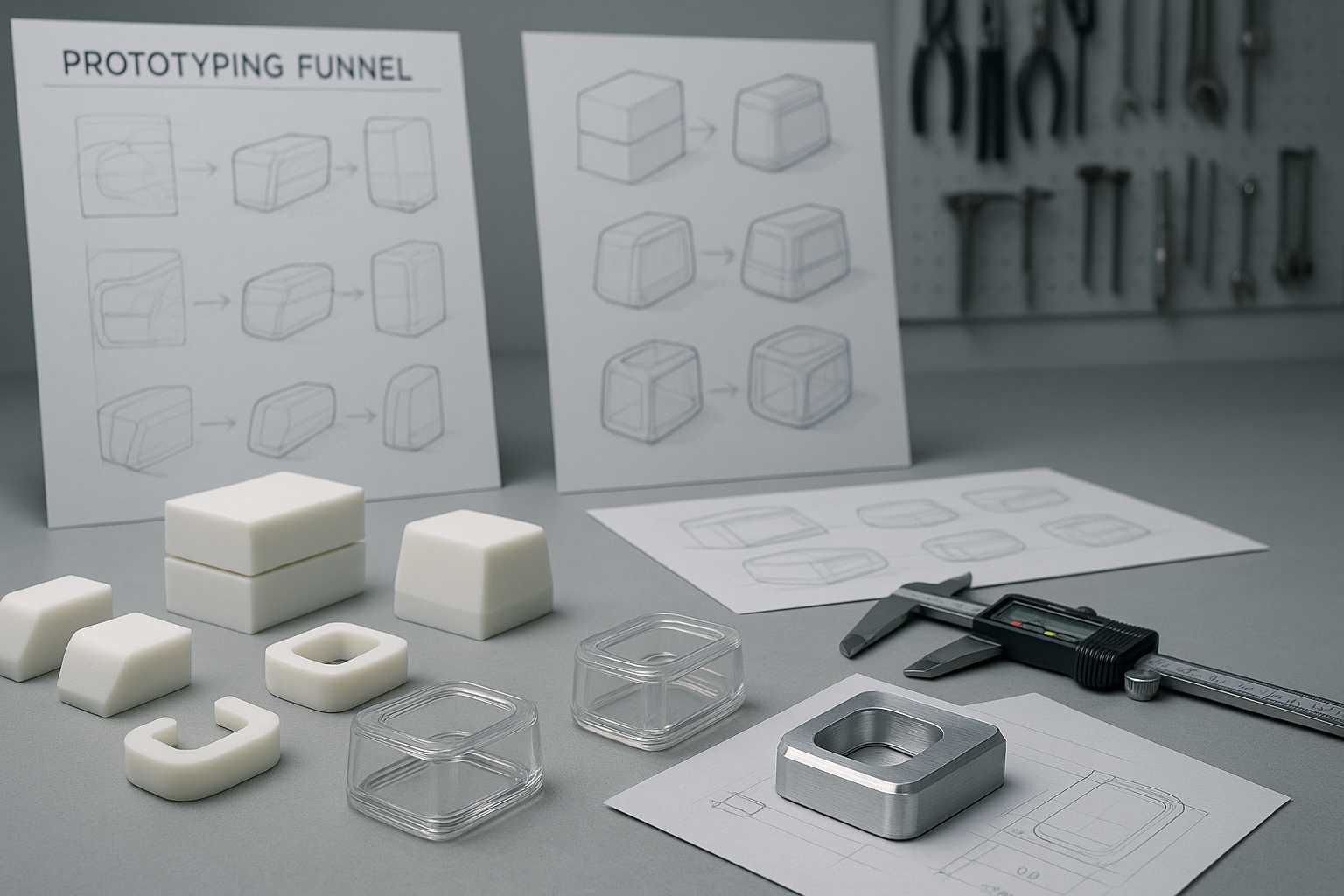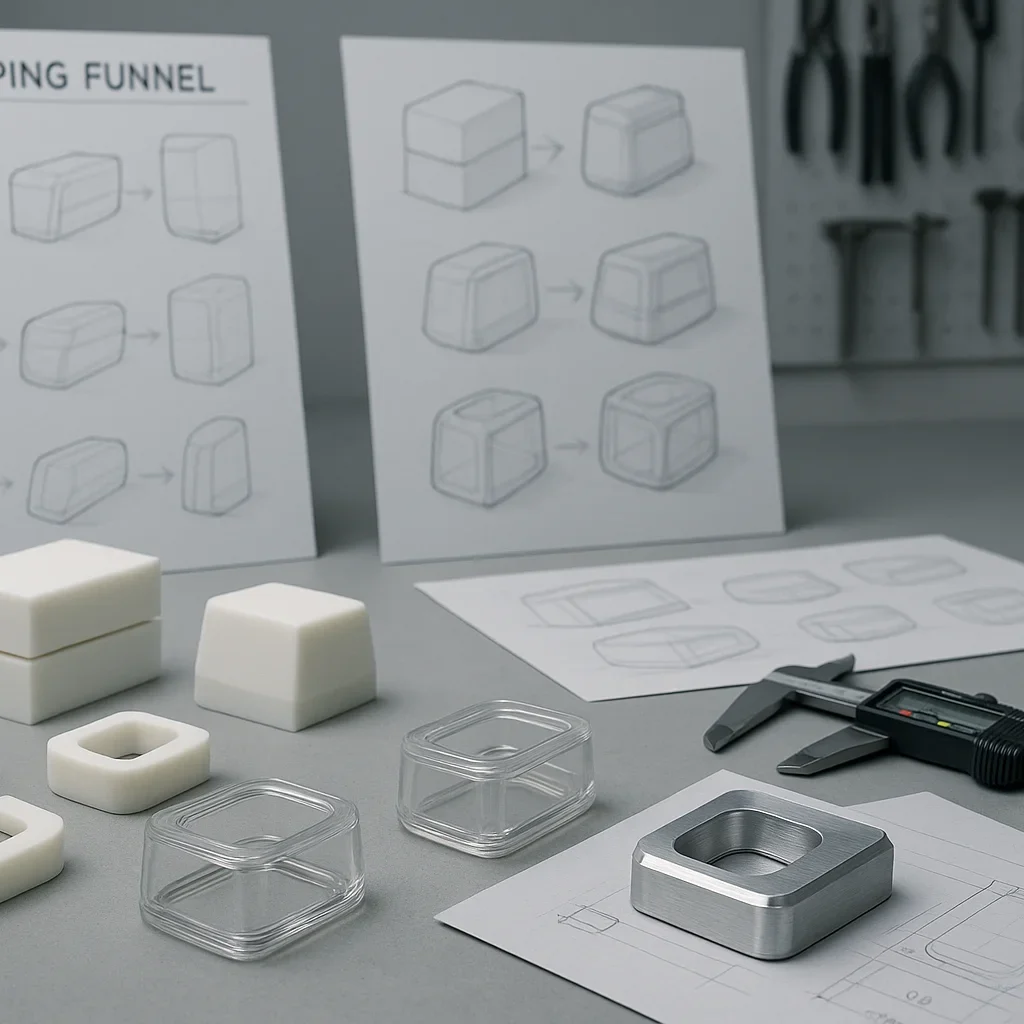

Rapid Prototyping
NEXAMS Leading the Way in Rapid Prototyping and On-Demand Manufacturing Solutions
Rapid prototyping is a transformative process that allows companies, including local startups and nearby innovators, to turn concepts into tangible models with speed and precision. At NEXAMS, we collaborate with trusted Vendors and reliable Suppliers to deliver a comprehensive suite of rapid prototyping services tailored to a wide range of industries, such as consumer electronics, medical devices, and automotive innovation. Our Manufacturers and technical Support teams ensure that every prototype is developed with ethical consideration and timely delivery.
Our approach leverages multiple technologies like sla printing, sls printing, cnc machining, and cnc routing to ensure fast, flexible, and functional output. By working closely with nearby Suppliers and regional Vendors, we integrate rapid prototyping cnc prototyping workflow and machining process expertise. This enables us to deliver superior machined parts with reduced lead times and lower development costs, all while offering Support that is human-like and driven by a deep sense of responsibility shared among our local Manufacturers.
From laser cutting for detailed sheet fabrication to injection molding for pilot production, NEXAMS is your nearby, trusted partner. We also work with liquid silicone for soft and transparent components and support various plastic molding processes for scalable prototyping. Our contract manufacturing team ensures full lifecycle Support—from early-stage prototype development with your local Supplier to production scaling with responsible Manufacturers and dedicated Vendors.
Benefits of Technology
Fast and cost-efficient production of complex geometries becomes achievable with the right Vendors and Manufacturers who offer local insight and regional Support to make decisions simpler and faster.
Integration of cnc routing and cnc machining for enhanced detail accuracy is made possible by ethical Suppliers and reliable Vendors that ensure each rapid prototyping cycle results in quality precision, backed by technical Support.
Allows testing of multiple design iterations via sla printing and sls printing, especially when coordinated by nearby Suppliers and regional Vendors aligned with trusted Manufacturers who believe in providing ongoing Support.
Builds functional prototype units using industrial-grade materials procured from certified Vendors and supported by local Suppliers, with all engineering decisions made collaboratively with Support-driven Manufacturers.
Enables seamless transition from rapid prototyping to contract manufacturing through nearby Vendors, local Supplier networks, and dependable Manufacturers who all contribute toward sustainable and supportive scaling efforts.
Simplifies production of both hard machined parts and soft liquid silicone models with the help of ethical Vendors, supportive Suppliers, and human-like decision-making across our local teams of Manufacturers.
Reduces turnaround time using direct-to-fabrication methods like laser cutting, aided by nearby Suppliers and responsible Vendors who coordinate closely with local Support engineers and efficient Manufacturers.
Ideal for pre-production validation using real-world materials and tolerances supplied by our trusted Vendors, reinforced by ethical Manufacturers and hands-on Support from local and nearby Suppliers.
Industrial Application and Use Cases
Automotive: Gear housings, dashboard panels, and functional prototype lighting components, developed with coordinated efforts between Vendors, local Suppliers, and automotive component Manufacturers who offer reliable Support at every stage.
Medical Devices: Custom casings using liquid silicone and bio-compatible sla printing, manufactured through Suppliers and Vendors who understand precision and safety with ethical Support from local medical-grade Manufacturers.
Aerospace: Lightweight plastic molding and complex parts made through cnc routing, provided by nearby Vendors and supported by Suppliers and Manufacturers who value Support and material responsibility.
Consumer Electronics: Enclosures, wearables, and small machined parts created by Vendors and handled by regional Suppliers, while local Manufacturers provide consistent and trusted engineering Support.
Product Design: Concept validation using rapid prototyping cnc prototyping and laser cutting with support from nearby Manufacturers, local Suppliers, and human-driven Vendors who help make decisions more efficient and effective.
Industrial Tools: Ergonomic handles and fixtures produced by sls printing and cnc machining by Vendors and Suppliers who deliver value with consistent Support from local tooling Manufacturers.
Robotics: Structural frames and brackets fabricated through cnc routing in collaboration with local Manufacturers, ethical Vendors, and dedicated Suppliers who emphasize safety, design accuracy, and ongoing Support.
Startups: Idea-to-market MVPs made possible with contract manufacturing Support and ethical guidance from local Vendors, regional Suppliers, and nearby prototyping Manufacturers committed to growth and success.
Material Used in Technology
ABS and PLA: Common thermoplastics used in rapid prototyping, sourced by local Suppliers and Vendors who prioritize sustainability and provide nearby Manufacturers with the right Support for part development.
Resins: Suitable for sla printing and high-resolution prototypes, distributed by trusted Vendors, with recommendations from Suppliers and ethical implementation by local Support-enabled Manufacturers.
Nylon and PA12: Preferred in sls printing for durability, these materials are regularly procured by reliable Suppliers and nearby Vendors who ensure material consistency for Manufacturers offering dependable Support.
Silicone Rubber: Utilized in liquid silicone molding for flexible parts, sourced through local Vendors and handled with precision by Suppliers who coordinate closely with nearby Support and Manufacturers.
Acrylic and Polycarbonate: Cut using laser cutting for transparency and toughness, available from ethical Vendors, well-informed Suppliers, and engineered under the guidance of local Manufacturers with collaborative Support.
Aluminum and Steel: Precision machined parts via cnc machining using metal blanks offered by regional Suppliers and local Vendors with consistent engineering Support from advanced metal Manufacturers.
Epoxy Composites: Used in functional prototype parts for thermal resistance and mechanical integrity, chosen by supportive Suppliers, processed by Vendors, and designed by Manufacturers with local Support networks.
How Costing Works
At NEXAMS, our rapid prototyping pricing model is built on a foundation of transparency and value. Complexity, material type, Supplier sourcing, Vendor coordination, and Manufacturer precision all play a role in cost. Local Support ensures clear communication at every stage.
A functional prototype using sls printing or sla printing is cost-effective for design evaluation. By working with nearby Suppliers and local Vendors, we can reduce risk and provide meaningful Support throughout the prototyping lifecycle.
CNC routing and cnc machining are slightly higher in cost due to material waste and tooling needs, but this is minimized with advice from responsible Vendors, guidance from nearby Suppliers, and precision from well-informed Manufacturers, all with ethical Support in place.
Low-run plastic molding or injection molding for bridge production benefits from economies of scale. Vendors and Suppliers collaborate with contract Manufacturers and Support engineers to deliver optimized batch pricing based on quantity and timeline.
From laser cutting of flat panels to complete machined parts, our transparent pricing ensures value without sacrificing quality—guided by ethical Vendors, regional Suppliers, and thoughtful, local Support from our Manufacturer network.
Alternative Technical Suggestion
FDM 3D Printing: Entry-level prototyping for form and fit, accessible through nearby Suppliers and small-scale Vendors with guidance from local Support teams and scalable options from regional Manufacturers.
Urethane Casting: Best for soft parts before liquid silicone molds, with Support from Vendors, sourcing from ethical Suppliers, and assistance from nearby Manufacturers specializing in early-stage soft tooling.
Sheet Metal Fabrication: Alternate to plastic molding for rigid enclosures, coordinated by Vendors and Suppliers who enable quicker iterations through decision-making Support from nearby Manufacturers.
Hybrid Prototyping: Combines cnc routing and sls printing for structural and aesthetic functionality, executed by ethical Vendors, trusted Suppliers, and supported by local precision Manufacturers.
RTV Molding: Ideal for low-run molds ahead of injection molding, guided by nearby Suppliers and handled by Vendors with full Support from local Manufacturers for quick turnaround projects.
Selective Laser Melting: Metal part alternative to conventional cnc machining, led by regional Vendors and metal Suppliers, with Support from advanced Manufacturers offering sustainable innovation.
Stereolithography: High-precision method for design models and functional prototype visualizations, made feasible by nearby Vendors and Suppliers with expert Support from reliable local Manufacturers.
FAQs
Q: What is rapid prototyping?
A: Rapid prototyping is a group of techniques used to quickly fabricate a scale model of a part using 3D data. This includes sla printing, cnc machining, and cnc routing to create functional prototypes for testing and validation, often coordinated by local Vendors and Suppliers with Manufacturer Support.
Q: What are the advantages of using rapid prototyping over traditional methods?
A: Rapid prototyping offers fast turnaround, design flexibility, reduced cost, and the ability to test multiple iterations quickly. With nearby Vendors, ethical Suppliers, and Supportive Manufacturers, it becomes a more collaborative and efficient path to innovation.
Q: How does CNC routing contribute to rapid prototyping?
A: CNC routing is essential for creating precise 2.5D and 3D components. Local Vendors and Suppliers ensure timely delivery and Support from nearby Manufacturers helps maintain part quality and consistency.
Q: What’s the difference between SLA printing and SLS printing in prototyping?
A: SLA printing offers high-detail resin parts, ideal for form validation. SLS printing provides durable powder-based prototypes. Vendors and Suppliers coordinate which is best, with Support from knowledgeable Manufacturers.
Q: Can I get end-use parts through rapid prototyping methods?
A: Yes. With the help of nearby Vendors, reliable Suppliers, and advanced Manufacturers, you can produce functional parts suitable for small-batch or MVP use, with full lifecycle Support.
Q: What are the typical lead times for machined parts?
A: With our streamlined Vendor and Supplier workflow and proximity to local Manufacturers, lead times can be as short as 2–5 business days, supported by agile operations and customer-focused Support.
Q: Is liquid silicone molding suitable for medical prototypes?
A: Absolutely. Our Vendors and Suppliers source biocompatible materials, and our ethical Manufacturers deliver clean, compliant results with Support throughout the development phase.
Q: What role does contract manufacturing play in scaling from prototype to production?
A: After prototyping, nearby Vendors and Suppliers help transition your parts to Manufacturers for mass production, with our Support ensuring quality control and local coordination.
Q: Why use laser cutting in prototyping?
A: Laser cutting enables fast shaping of flat materials. Vendors and Suppliers provide input while local Manufacturers and Support teams ensure precise fabrication for your needs.
Q: How do I choose between plastic molding and CNC machining for my prototype?
A: For high volumes or internal cavities, plastic molding is best. For tighter tolerances or metals, CNC machining is ideal. Our Vendors, Suppliers, and local Support experts will guide you ethically through this decision.
A: By Sea: Asia: 15–20 days, Europe: 25–35 days, North America: 30–40 days, South America: 35–45 days, Middle East: 14–18 days, Africa: 20–28 days, Oceania: 22–30 days
By Air: Asia: 1–3 days, Europe: 3–5 days, North America: 4–6 days, South America: 5–7 days, Middle East: 1–2 days, Africa: 3–5 days, Oceania: 4–6 days
